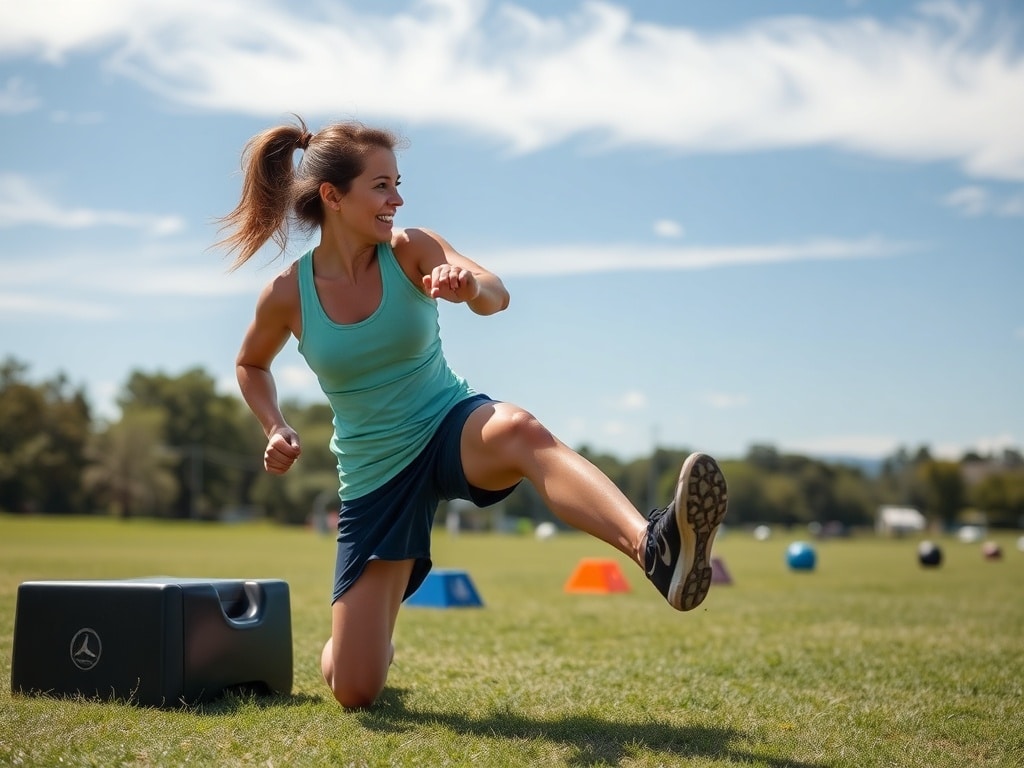Unlock Your Agility: Mobility Exercises for Pain-Free Living After 50
What is Mobility and Why Does it Matter After 50?
Imagine moving through your day with ease – bending, reaching, and twisting without a second thought. That’s the essence of mobility: the ability of your joints to move freely and fluidly through their full range of motion. It’s more than just flexibility; it’s about control and strength within that range. After 50, maintaining or regaining mobility becomes incredibly important. It’s the key to staying active, independent, and pain-free.
As we age, our bodies naturally undergo changes. Connective tissues become less elastic, muscles weaken, and joint stiffness can set in. This can lead to a cascade of problems, from difficulty performing simple tasks like reaching for a top shelf to debilitating pain that limits your ability to enjoy life. Mobility exercises are a proactive way to combat these age-related changes, keeping your joints lubricated, your muscles strong, and your body moving with grace.
Mobility vs. Flexibility: Understanding the Difference
While often used interchangeably, mobility and flexibility are distinct but related concepts. Flexibility refers to the ability of a muscle to lengthen, allowing for increased range of motion at a joint. Think of stretching your hamstrings.
Mobility, on the other hand, encompasses flexibility and also involves joint strength, coordination, and the nervous system’s ability to control movement. It’s about *activelymoving a joint through its full range of motion with control and stability. You might be flexible enough to touch your toes, but can you squat deeply with good form and stability? That’s mobility.
Mobility is vital for functional movements, injury prevention, and overall athletic performance at any age; and more so the older your get.
Common Mobility Limitations After 50
Several common mobility limitations tend to affect individuals over 50:
- Stiff Joints: Age-related changes in cartilage and synovial fluid can lead to stiffness, particularly in the knees, hips, and spine.
- Back Pain: Reduced spinal mobility can contribute to back pain and discomfort.
- Hip Tightness: Prolonged sitting and decreased activity can cause tightness in the hip flexors and surrounding muscles, limiting hip extension and rotation.
- Shoulder Impingement: Decreased shoulder mobility can lead to impingement, where tendons become compressed and irritated.
Addressing these limitations with targeted mobility exercises can significantly improve quality of life.
The Broad Benefits of Mobility Exercises
The advantages of including mobility routines in your life have far reaching effects on your overall health and well-being, including:
- Pain Reduction: Enhanced joint mobility can alleviate pain associated with arthritis, stiffness, and muscle imbalances.
- Improved Posture: Increased spinal and hip mobility can improve posture and reduce strain on the back and neck.
- Enhanced Balance: Mobility exercises improve proprioception (body awareness), reducing the risk of falls.
- Increased Energy Levels: Moving more freely requires less effort, leading to increased energy levels and reduced fatigue.
- Greater Independence: Maintaining mobility allows you to perform daily activities with greater ease and independence.
- Better Sports Performance: If you enjoy sports or recreational activities, better mobility can enhance your performance and reduce the risk of injuries.
Priming the Body: Essential Warm-Up Exercises
Before diving into mobility exercises, it’s crucial to warm up your body to increase blood flow to the muscles and prepare your joints for movement. A good warm-up should include:
- Light Cardio: 5-10 minutes of brisk walking, marching in place, or cycling.
- Dynamic Stretching: Arm circles, leg swings, torso twists, and other movements that take your joints through their range of motion.
Avoid static stretching (holding a stretch for an extended period) before mobility exercises, as it can temporarily reduce muscle power.
Neck Mobility: Releasing Tension and Improving Range
These exercises can help improve neck mobility and reduce stiffness:
- Chin Tucks: Gently draw your chin towards your chest, lengthening the back of your neck. Hold for a few seconds, then release. Repeat 10-15 times.
- Neck Rotations: Slowly turn your head to the right, then to the left, as far as comfortable. Repeat 10-15 times on each side.
- Neck Tilts: Gently tilt your head to the right, bringing your ear towards your shoulder. Repeat on the left side. 10-15 times on each side.
Move slowly and avoid pushing through any pain.
Shoulder Mobility: Enhancing Upper Body Movement
These are great exercises for shoulder and rotator cuff mobility:
- Arm Circles: Make small circles with your arms forward, then backward. Gradually increase the size of the circles. Perform 10-15 repetitions in each direction.
- Shoulder Rolls: Roll your shoulders forward, then backward, in a circular motion. 10-15 repetitions in each direction.
- Cross Body Shoulder Stretch: Pull one arm across into your chest and hold with the opposite arm. Hold for 30 seconds and repeat with the other side.
Thoracic Spine Mobility: Improving Rotation and Posture
These can relieve back pain and improve posture:
- Cat-Cow Stretch: On your hands and knees, alternate between arching your back (cat pose) and dropping your belly towards the floor (cow pose). Repeat 10-15 times.
- Torso Twists: Sit with your feet flat on the floor and your knees bent. Gently twist your upper body to the right, then to the left. 10-15 repetitions on each side.
Focus on moving through your upper back, not just your lower back.
Hip Mobility: Enhancing Lower Body Movement
These exercises are great for ungluing the hips:
- Hip Circles: Stand with your feet shoulder-width apart. Make large circles with your hips in both directions. 10-15 repetitions in each direction.
- Leg Swings: Hold onto a chair or wall for support. Swing one leg forward and backward, then side to side. 10-15 repetitions with each leg in each direction.
- Figure-Four Stretch: Lie on your back with your knees bent. Place your right ankle on your left knee. Gently pull your left thigh towards your chest until you feel a stretch in your right hip. Hold for 30 seconds, then repeat on the other side.
Knee Mobility: Maintaining Joint Health
Improve your bending and straightening abilities with these strategies:

- Knee Circles: Stand with your feet together and your hands on your knees. Make small circles with your knees in both directions. 10-15 repetitions in each direction.
- Leg Extensions: Sit in a chair with your feet flat on the floor. Extend one leg straight out in front of you, then slowly lower it back down. Repeat 10-15 times with each leg.
If you have knee pain, consult with a healthcare profession before trying these exercises.
Ankle Mobility: Improving Balance and Stability
Exercises to help you stay stable and upright:
- Ankle Circles: Sit or lie down and rotate your ankles in both directions. 10-15 repetitions with each ankle.
- Calf Stretches: Stand facing a wall, place one foot slightly behind the other, and press your hips forward while keeping your back heel on the ground. You should feel a stretch in you calf.
Sample Mobility Routine for Beginners Over 50
Here’s a sample easy routine to get you started:
- Warm-up (5-10 minutes): Light cardio and dynamic stretching (arm circles, leg swings).
- Neck Mobility (5 minutes): Chin tucks, neck rotations, neck tilts.
- Shoulder Mobility (5 minutes): Arm circles, shoulder rolls.
- Thoracic Spine Mobility (5 minutes): Cat-cow stretch, torso twists.
- Hip Mobility (5 minutes): Hip circles, leg swings.
- Knee Mobility (5 minutes): Knee circles, leg extensions.
- Ankle Mobility (5 minutes): Ankle Circles and calf stretches
Perform this routine 3-5 times per week, or whenever you need to loosen up. Again, it is important to warm up before starting the exercises and move slowly!
Safely Building Your Mobility
Progression is an important part of staying challenged and reaching longer-term mobility goals:
- Increase Range of Motion: As you become more comfortable with the exercises, try to gradually increase the range of motion of your joints.
- Add Resistance: Once you can comfortably perform the exercises with bodyweight, you can add light resistance using resistance bands or light weights.
- Increase Frequency: Gradually increase the number of times you perform the routine each week.
Mistakes To Steer Clear From
Common mistakes can be avoided to improve outcomes:
- Forcing Movements: Never push through pain or force a joint beyond its comfortable range of motion.
- Holding Your Breath: Breathe deeply and consistently throughout the exercises.
- Ignoring Pain: Pay attention to your body and stop if you experience any sharp or persistent pain.
- Skipping Warm-ups: Always warm up your body before performing mobility exercises.
Breath and Movement
Conscious breathing can enhance the effectiveness of mobility exercises. Inhale deeply to expand your chest and create space in your joints, and exhale fully to release tension and promote relaxation. Focus on coordinating your breath with your movements, inhaling as you move into a stretch and exhaling as you release it.
Make it a Habit
Incorporating these exercises into your daily routine can be as simple as:
- Morning Routine: Start your day with a quick mobility routine to loosen up your joints and prepare your body for the day ahead.
- Desk Breaks: Take short breaks throughout the day to perform neck and shoulder mobility exercises.
- Evening Routine: Wind down with a gentle mobility routine to relax your muscles and improve sleep quality.
Other Lifestyle Choices that Benefit Mobility
Mobility isn’t just about exercise; other lifestyle factors also play a crucial role:
- Nutrition: A balanced diet rich in fruits, vegetables, and healthy fats can reduce inflammation and support joint health.
- Hydration: Staying adequately hydrated helps lubricate your joints and keep your tissues pliable.
- Regular Activity: In addition to mobility exercises, engage in regular physical activity such as walking, swimming, or cycling to maintain overall fitness and joint health.
When to Ask a Doctor
When it comes to symptoms and pain, listening to your body is essential. Pay attention if you feel:
- Severe Pain: Consult a healthcare professional for sharp, severe and persistent pain.
- Limited ROM: If you have a hard time doing a mobility exercise, talk to a professional about your form and body limitations.
- Unsure what to do: If you have any underlying conditions that may make exercise dangerous, check with your doctor before engaging in any mobility activities.
A Little Help Goes A Long Way
Certain tools and equipment can assist in performing mobility exercises:
- Foam Rollers: Foam rollers can be used to massage muscles and release tension, improving flexibility and mobility.
- Resistance Bands: Resistance bands can add resistance to mobility exercises, increasing strength and stability.
- Yoga Blocks: Yoga blocks can provide support and stability during certain stretches and exercises.
Staying Motivated
Consistency is key to achieving long-term benefits. Stay motivated by:
- Tracking Progress: Keep a journal to track your progress and celebrate your achievements.
- Finding a Partner: Work out with a friend or family member for added motivation and accountability.
- Setting Goals: Set realistic goals and reward yourself when you reach them.

